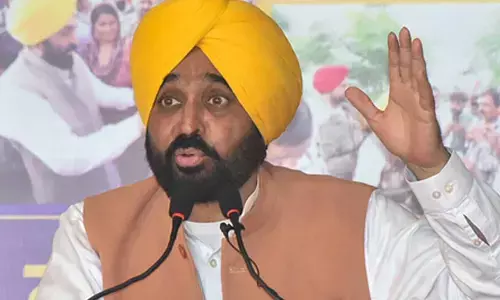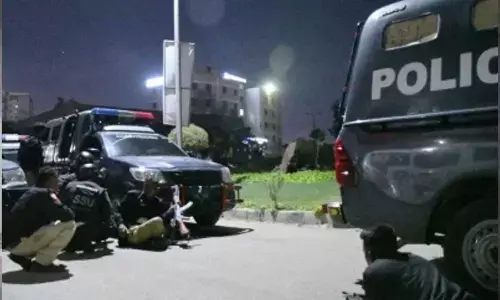Aircraft carriers are inalienable from our maritime security

Aircraft carriers are inalienable from our maritime security
India’s Indigenous Aircraft Carrier (IAC) Vikrant successfully carried out five-day sea trials this month to test the performance of the 40,000-tonne warship.
India's Indigenous Aircraft Carrier (IAC) Vikrant successfully carried out five-day sea trials this month to test the performance of the 40,000-tonne warship. It is quite formidable – 262 metres long, 62 metres at the widest part and a height of 59 metres. It has 14 decks and carry MiG-29K fighter jets, Kamov-31 helicopters, MH-60R multi-role helicopters etc.
It not only epitomises a significant milestone in the country's native techno-industrial prowess but also marks the fulfilment of a dream long nurtured by a nation aspiring to revive its maritime tradition and restore to itself the prestige it held among seafaring countries in the past.
Indeed, the impact of sea power in shaping India's past and the role that it would play in forging her future had been well understood by our national leadership and strategists alike, and soon after independence the Indian Navy (IN) embarked on a cogently articulated plan to strengthen its capabilities. Specifically, within six months of Independence, the Navy drafted a ten-year expansion plan which, inter alia, included two light fleet carriers to be later replaced by four fleet carriers. This focus on carrier borne airpower emerged from the experiences of the Second World War where aircraft carriers indubitably played a central role on both sides. But it wasn't the Navy alone which sought to bolster its aviation capabilities.
The eminent civil servant, historian and strategic thinker, Sardar KM Panikkar presciently noted in his book titled India and the Indian Ocean: An Essay on the Influence of Sea Power on Indian History (1945). "Equally important, especially for a country like India, with a vast coastline is the development of a naval air arm, as an integral part of the sea forces. The naval air arm has an important part to play in naval warfare, by patrolling the coasts, by keeping the sea clear and affording air cover to the navy."
Sure enough, the Indian Navy created a Directorate of Naval Aviation in 1948, five years before the first Sea-land aircraft were inducted. However, due to the vicissitudes of limited budget versus enormous demands for public spending from all sectors, the Navy's requirement of a strong air arm and aircraft carriers was trimmed in 1950 to only a Fleet Requirement Unit (FRU) with 12 aircraft. Notwithstanding the vagaries of defence budget, Indian naval aviation followed a sure-footed trajectory of growth - from Sea-land aircraft to Firefly, Vampire, Alize, Sea Harrier and Mig 29K; from Super Constellation to IL 38, Tu 142, Dornier and P 8I; a variety of helicopters and augmentation of infrastructure, technological base and quality manpower.
Carrier aviation is ostensibly the bellwether of a navy's aviation prowess. That is perhaps the reason why those who possess it desire to preserve it and those who do not, aspire for it. The operational history of the IN's carriers is illustrative of the capabilities of carriers. Late Vice Admiral GM Hiranandani has accurately chronicled the deployment of INS Vikrant during the 1971 Indo-Pak war in his book, 'Transition to Triumph: The Indian Navy.' In this war, INS Vikrant dominated the Eastern maritime theatre where it repeatedly struck ports in East Pakistan (now Bangladesh), destroyed about 60,000 tonns of merchant shipping and sank a number of Pakistani war vessels. In sum, Vikrant was instrumental in enforcing a maritime blockade of East Pakistan.
In recent years, aircraft carriers have proven their capability in various conflicts such as the First Gulf War in 1990 (Operation Desert Storm), the War on Terror in Afghanistan in 2001 (Operation Enduring Freedom) and the Second Gulf War in 2003 (Operation Iraqi Freedom). Significantly, carriers have played an equally crucial role in containing and managing less than war situations, demonstrating national will and supporting friendly countries. In India's context, the possible roles of aircraft carriers could be supporting the land battle, security of Sea Lines of Communication, protecting vital interests overseas and defence of island territories. Captain Gurpreet Khurana of the Indian Navy has elucidated these roles in an article titled eAircraft Carriers and India's Naval Doctrine'.
While most advanced navies accept the importance of aircraft carriers, critics have often called these versatile platforms as a "self-licking ice-cream cone" and a "white elephant", highlighting the need for a large number of escorts to protect the carrier. Lee Willet has rebutted such criticism in the book 'British Naval Aviation : The First Hundred Years'. He calls attention to the fact that "no carrier has been sunk since 1945 and the vulnerability of carriers is not a military matter but an enduring one for budgetary and inter-service battles". Former Navy Chief Admiral Arun Prakash is of the view that rather than needing protection from a large number of escorts, the carrier actually provides protection to the force that may accompany it.
Although the debate on the cost effectiveness of aircraft carriers is likely to continue, their role and need in naval warfare cannot be overstated. The United States, for example, was only able to respond to the Korean crisis in time because it had readily deployable carriers on call. Similarly, it was the carriers HMS Hermes and HMS Invincible that enabled the United Kingdom to defend the Falkland Islands.
In an incisive article titled "Lessons from Modern Warfare: What the Conflicts of the Post-Cold War Years Should Have Taught Us", Benjamin Lambeth concludes that aircraft carriers can substitute land-based airpower and sometimes they are the only available option for wielding airpower.
Very often, though, aircraft carriers supplement land-based airpower, as evidenced by the performance of the US Navy's carriers in Operation Iraqi Freedom. The navy, by virtue of its mobility, reach, sustainability and versatility can preserve our maritime interests overseas as well as at home in our maritime zones and island territories. However, when ships are deployed beyond the reach of shore-based aircraft, they require support from carrier-based aircraft. This ability of the aircraft carriers to protect own forces and project power ashore is what makes them a key component of naval power.
As India prepares to secure its maritime interests in a gradually changing global strategic stage, there is an emergence of a complex security scenario in the Indian Ocean Region (IOR) and beyond. The rise of an assertive China and its far-reaching repercussions across economic, geo-strategic and cultural domains symbolises the turbulence in global affairs in general and the Indo-Pacific in particular. The rapid modernisation of the Chinese Navy - which is now the world's largest navy, according to a report released earlier this year by the United States Department of Defence - is of primary concern to its neighbours. The Chinese Navy presently operates two aircraft carriers and is building two more which would be significantly larger and more capable. The consequences of such an exponential growth in China's naval capability will most likely have consequences for India's maritime security.
The pan-IOR vision of Security and Growth for All in the Region (SAGAR) articulated by the Indian Prime Minister requires a robust and agile Navy which is capable of ensuring secure seas in our areas of maritime interest and responding to a wide range of potential crises in the region. Aircraft carriers are the sine qua non for such a Navy which aspires to secure core national interests. It is through perspicacity of the Navy's earliest leadership and the consistent guidance and course corrections of their successors, that the Indian Navy has built a credible and effective air arm today. This needs to be preserved and further bolstered in order to forge an adaptive capability to address the emerging regional maritime challenges.
(Binay Kumar Singh is an author & researcher)














